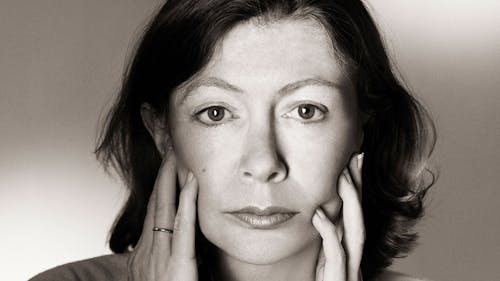Reflection: Joan Didion's impact was personal, not just universal

I write my collected musings beneath a bulletin board of memories. Ubiquitous candy wrappers stolen from my grandmother’s purse join paper menus, placed beside free pins picked up at comic book stores and letters from loved ones, right next to a trinket I found on a walk and a drawing a friend gave me when I was 14 — all of it creating a collage of unexplainable connections.
I look up now, and a photo from a film camera that once fixed its lens on a younger face — one that I have to remind myself was mine — looks down at me, mouth parted, cheeks rosy, eyes lazily meeting my gaze.
Just underneath a business card for an antique store in Somerville, New Jersey, called “Living In The Past,” is a black-and-white picture of Joan Didion, photographed by Henry Clarke for Vogue in 1972. And right next to that, there's a line from an article about peaches in a thrifted 1968 magazine that reads, “the freckled fruit brings sun flavor to cold-weather salads and desserts.”
And she did. With her searing prose and achingly acute approach to reporting and storytelling, Didion brought something daring to reporting — a narrative, first-person structure that revealed her bias in order for her to report fairly.
Didion died on Dec. 23, 2021, at 87 years old. Her work as an essayist, journalist, screenwriter and author has inspired writers for generations.
“Every choice one made alone — every word chosen or rejected, every brushstroke laid or not laid down — betrayed one’s character. Style is character,” wrote Didion about the artist Georgia O’Keefe in her collected book of essays “The White Album.”
If style is character, what do Didion’s words say about her?
Using the first person is always a big journalism no-no, but Didion changed that. She explored herself as a subject and how she, as a subject, related to the events and people that she was reporting on. Her Hemingway-like deadpanned-ness and structure only added to her sharp gaze and unwavering stare.
Didion’s most famous work includes a collection of essays called “Slouching Towards Bethlehem,” “Play It as It Lays” and her works on grief after losing her husband and daughter in the same year, “The Year of Magical Thinking” and “Blue Nights."
She is also well-known for being one of the first journalists to suggest that the Central Park Five, a group of Black and Latinx kids who were wrongfully convicted of aggravated assault, were innocent — which turned out to be true.
Didion came to me by mistake — I took a class called Literary Journalism this time last year and contracted it as an honors course. In exchange for skipping an honors STEM class, I had to write a 10-page paper about a journalist that adopted narrative techniques to approach reporting. I chose Didion on a list of 10 literary journalists at random because she was 1 of the only 2 women on the entire syllabus.
Part of the deal I made with my professor was to read three additional books. I read five.
I went one winter night to seek out “Blue Nights,” the fourth Didion book I read, because I was hurting, and Didion was the only one who could contextualize the existential grief inside of me. As I was searching for the book, I passed five copies of “The Year of Magical Thinking,” the book she wrote after her husband died. Without thinking, I creased the corner of page 139 of each copy available.
The page depicts a scene where Didion obsesses over a line that her husband, the author John Gregory Dunne, wrote. She’s convinced that there’s a grammatical mistake in one of the chapters of Dunne’s books. The line in question reads, “‘It seemed logical. Like lightning. You were worried. I didn’t want you worried.’ It was as close a declaration of love as J.J. was capable of making.”
When I read about Didion’s fixation the first time, I thought about why Didion decided not to change her late husband’s manuscript if she was convinced it contained an error and, more importantly, why she cared so much in the first place. Then I thought that perhaps Didion saw something in the J.J. character that reminded her of herself, and things started to make more sense.
The obsession with the mistake: It was as close a declaration of love as J.D. was capable of making.
The few people that have seen the bulletin board in my room remark on its beauty, on my attention to detail. They don’t know that it’s fear that keeps the leaf suspended above me. And they don’t know that it’s that same fear of loss that made Didion such a phenomenal writer.
The last words of “Blue Nights,” which is about the death of Didion's daughter, Quintana Roo Dunne, is also Didion’s terrifying farewell. She writes, “The fear is for what is still to be lost. You may see nothing still to be lost. Yet there is no day in her life on which I do not see her.”
The peering eyes. The receipts from dinners with friends I can’t bear to keep in touch with. A secret confession of love discerned from a rogue grammatical mistake. The 10-paged trade. All of it is woven into nothing more than a story I tell you in order to live.



